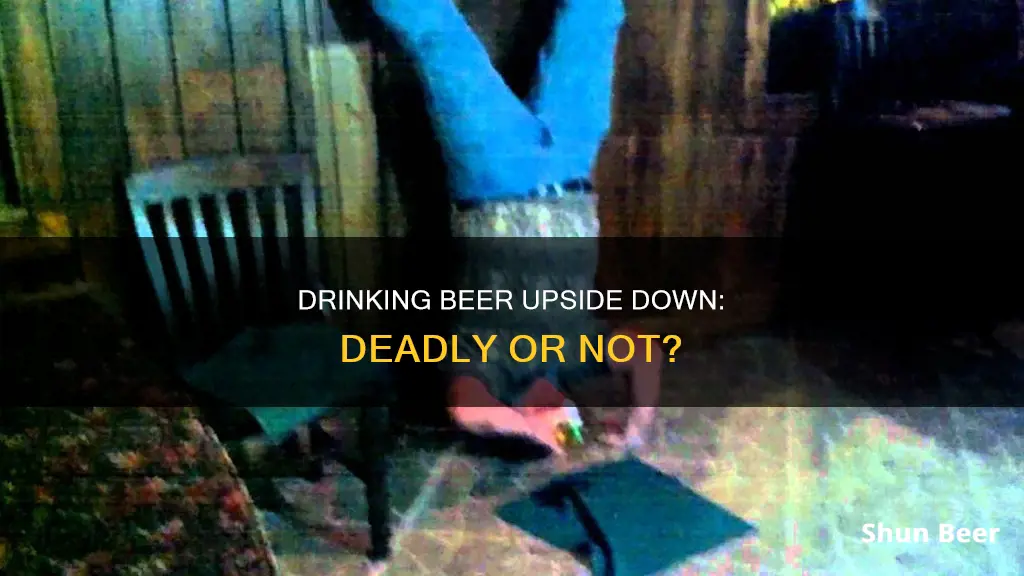
Drinking beer upside down is a party activity that involves a person chugging beer from a keg while doing a handstand. This activity is called a keg stand and is a staple in American college culture. Keg stands can be dangerous as they combine the risks of performing a handstand with the alcoholic side effects of beer. Drinking large amounts of beer in a single sitting can lead to alcohol poisoning or overdose, causing dizziness, nausea, increased blood alcohol concentration, and potential permanent damage to the brain and other organs. While drinking beer upside down may not directly kill you, it can increase the risk of injury and alcohol-related health issues.
What You'll Learn

Keg stands can be dangerous
Firstly, the act of doing a handstand on a keg of beer can be dangerous in itself. If the person performing the keg stand is already intoxicated, they may lose their balance and fall, potentially hitting their head or causing other injuries. This is what happened to Seth Korona, a student at Indiana University, who was killed after hitting his head while performing a keg stand in 2002.
Secondly, drinking a large amount of beer in a single sitting, as encouraged by keg stands, can lead to alcohol poisoning or overdose. The side effects of alcohol consumption include dizziness, nausea, increased blood alcohol concentration, and potentially permanent damage to the brain, liver, and other organs.
In addition, the combination of a handstand and rapid alcohol consumption can be a dangerous mix. The rush of blood to the head, combined with the intoxicating effects of alcohol, can lead to dizziness, fainting, and an increased risk of falling.
Furthermore, the social pressure and competitive nature of keg stands can contribute to their danger. Participants may feel pressured to consume more alcohol than they normally would or to continue drinking even when they have already reached their limit. This can lead to dangerous levels of alcohol consumption and increase the risk of alcohol poisoning.
Finally, the use of a keg tap in the mouth during a keg stand can also pose a risk. If the tap is not clean or properly sanitized, it could introduce bacteria or other contaminants into the drinker's mouth, leading to potential health issues.
In conclusion, while keg stands may be a popular party activity, it is important to recognize the potential dangers associated with them. The combination of a handstand, rapid alcohol consumption, social pressure, and the use of a keg tap can lead to serious injuries, health issues, and even death. It is important to drink responsibly and be aware of the risks involved in activities such as keg stands.
Beer and Protein Shakes: Safe Combo or Not?
You may want to see also

Beer funneling and intoxication
Beer funneling, also known as "beer bonging", is a drinking technique where beer is poured into a funnel attached to a tube, allowing for rapid consumption. This method of drinking is popular, especially among college students, as it is a quick and efficient way to get drunk. The height from which the beer is poured directly into the mouth increases the speed of intake, leading to rapid intoxication.
The process of beer bonging involves pouring beer into a large funnel, which is then attached to a tube. As the user drinks, the beer flows down the tube with the help of gravity. This technique removes control over the volume of liquid entering the mouth, and the force of gravity can trigger the gag reflex. Beer bonging can be done in two ways: taking a hit or chugging. A hit involves using a valve to control the flow of beer, while chugging involves consuming an entire beer or multiple beers in one go.
The use of a beer bong can lead to intoxication very quickly, and it is important to drink responsibly and be aware of your limits. Beer funneling increases the speed of alcohol consumption, and the rapid intake can lead to drunkenness faster than sipping from a glass. This method of drinking can be dangerous, especially when combined with an empty stomach, as it can lead to a higher risk of alcohol poisoning.
Alcohol poisoning occurs when there is an excessive amount of alcohol in the bloodstream, affecting life-supporting functions such as breathing, heart rate, and consciousness. It can be life-threatening and requires immediate medical attention. Drinking a large amount of beer in a single sitting, as is common with beer funneling, increases the risk of alcohol poisoning and can have serious side effects, including dizziness, nausea, increased blood alcohol concentration, and potential permanent damage to the brain, liver, and other organs.
It is important to note that beer funneling can have serious consequences and should be approached with caution. While it may be a popular way to consume alcohol, particularly in social settings, it is crucial to prioritize health and safety by drinking responsibly and being mindful of potential risks.
Wheat-Free, Beer-Friendly: Enjoying Beer Without Wheat
You may want to see also

Drinking upside down for flavour
Drinking beer upside down is not inherently dangerous, but it is often associated with risky drinking practices, such as keg stands and funneling, which can lead to rapid intoxication and alcohol poisoning. However, the practice of drinking beer upside down can also be done for flavour.
When beer is stored upside down, the yeast settles at the bottom of the bottle. This gives the beer a clearer appearance and allows the drinker to better taste the hops and malt flavours. Additionally, drinking from the bottle upside down may help prevent foam from forming at the top of the glass, which can interfere with the flavour of the beer.
To get the full flavour benefits of drinking beer upside down, it is important to ensure that the beer has been stored upside down for a period of time before drinking. This allows the yeast to settle and the flavours to enhance. It is also important to drink responsibly and in moderation, as excessive alcohol consumption can be dangerous and have negative health consequences.
When drinking beer upside down for flavour, it is also worth considering the type of beer being consumed. Different beers have different flavour profiles, and some may be better suited to being consumed upside down than others. For example, a hoppy IPA or a malt-forward amber ale may showcase their flavours more effectively when drunk upside down, as the yeast settling at the bottom of the bottle can reduce the bitterness or maltiness that might otherwise be more prominent.
In addition to enhancing flavour, drinking beer upside down can also be a fun and unique way to enjoy a beverage. It adds an element of novelty to the drinking experience and can be a great conversation starter at parties or social gatherings. However, it is important to remember to always drink responsibly and to be mindful of the potential risks associated with excessive alcohol consumption, regardless of the method of drinking.
Drinking Non-Alcoholic Beers: How Many Is Too Many?
You may want to see also

Drinking games and challenges
Another drinking activity is the "keg stand", which involves doing a handstand on a keg of beer and attempting to drink as much as possible at once or for as long as possible. This activity can be dangerous, as it combines the risks of performing a handstand with the alcoholic side effects of the beer. In one tragic case, a student at Indiana University was killed after hitting his head while performing a keg stand.
It is important to remember that drinking a large amount of beer, especially during a single sitting, can lead to alcohol poisoning or overdose. Side effects of alcohol consumption include dizziness, nausea, increased blood alcohol concentration, and potential permanent damage to the brain, liver, and other organs. Therefore, it is crucial to drink responsibly and be mindful of your limits when participating in drinking games and challenges.
Beer and Amnesteem: Is It Safe to Drink Alcohol?
You may want to see also

Alcohol poisoning
Drinking beer upside down will not kill you, but drinking large amounts of beer in a short space of time can lead to alcohol poisoning, which can be fatal. Alcohol poisoning, or alcohol overdose, occurs when there is too much alcohol in the bloodstream that parts of the brain that control vital life-support functions begin to shut down. These functions include breathing, heart rate, and temperature control.
The risks of alcohol poisoning are heightened when drinking large amounts of beer, especially during a single sitting. Binge drinking, defined as a pattern of drinking that brings blood alcohol concentration (BAC) to 0.08% or higher, is a major cause of alcohol poisoning. For men, this means having five or more drinks in less than two hours, and for women, it is four or more drinks in the same time frame.
The signs of alcohol poisoning include mental confusion, difficulty remaining conscious, vomiting, seizures, trouble breathing, slow heart rate, dulled responses (such as no gag reflex), and extremely low body temperature. These symptoms can lead to choking on one's own vomit, causing death from a lack of oxygen. Even if the person survives, alcohol poisoning can lead to long-lasting brain damage.
If you suspect someone is experiencing alcohol poisoning, it is important to take immediate action. Call emergency services right away, don't leave the person alone, and try to keep them awake and seated upright. If they are passed out, place them on their side to prevent choking. Keep them covered with a warm blanket and provide paramedics with information about their symptoms and alcohol consumption.
Beer and Afib: What You Need to Know
You may want to see also
Frequently asked questions
Drinking beer upside down is not inherently dangerous, but drinking too much beer, especially in a single sitting, can cause alcohol poisoning or overdose.
Side effects of alcohol poisoning include dizziness, nausea, increased blood alcohol concentration, and potentially permanent damage to the brain, liver, and other organs.
A keg stand is a drinking activity where the participant does a handstand on a keg of beer and attempts to drink as much as possible at once or for as long as possible.
Keg stands exhibit the same risks as performing a regular handstand, but the alcoholic side effects of the beer may increase the level of harm.
Drinking beer upside down will not kill you, but consuming large amounts of alcohol in a short period of time can lead to alcohol poisoning, which can be fatal.







